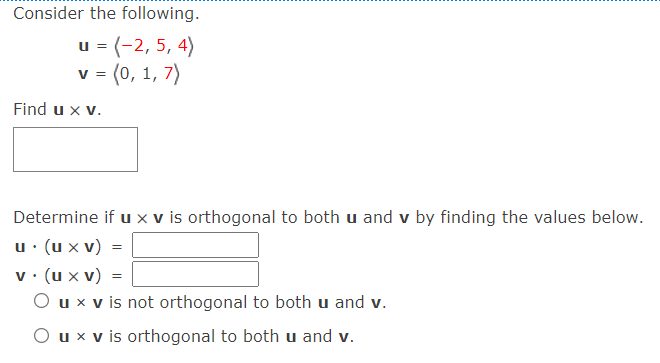Consider the following. u = (-2, 5, 4) v = (0, 1, 7) %3D Find u x v. Determine if u x v is orthogonal to both u and v by finding the values below. u: (u x v) v • (u x v) O ux v is not orthogonal to both u and v. %3D = O ux v is orthogonal to both u and v.
Consider the following. u = (-2, 5, 4) v = (0, 1, 7) %3D Find u x v. Determine if u x v is orthogonal to both u and v by finding the values below. u: (u x v) v • (u x v) O ux v is not orthogonal to both u and v. %3D = O ux v is orthogonal to both u and v.
Linear Algebra: A Modern Introduction
4th Edition
ISBN:9781285463247
Author:David Poole
Publisher:David Poole
Chapter1: Vectors
Section1.2: Length And Angle: The Dot Product
Problem 52EQ
Related questions
Question

Transcribed Image Text:Consider the following.
u = (-2, 5, 4)
v= (0, 1, 7)
V =
Find u x v.
Determine if u x v is orthogonal to both u and v by finding the values below.
u · (u x v)
v• (u x v) =
O ux v is not orthogonal to both u and v.
O ux v is orthogonal to both u and v.
Expert Solution
This question has been solved!
Explore an expertly crafted, step-by-step solution for a thorough understanding of key concepts.
Step by step
Solved in 2 steps with 2 images

Recommended textbooks for you

Linear Algebra: A Modern Introduction
Algebra
ISBN:
9781285463247
Author:
David Poole
Publisher:
Cengage Learning

Elementary Linear Algebra (MindTap Course List)
Algebra
ISBN:
9781305658004
Author:
Ron Larson
Publisher:
Cengage Learning

Algebra & Trigonometry with Analytic Geometry
Algebra
ISBN:
9781133382119
Author:
Swokowski
Publisher:
Cengage

Linear Algebra: A Modern Introduction
Algebra
ISBN:
9781285463247
Author:
David Poole
Publisher:
Cengage Learning

Elementary Linear Algebra (MindTap Course List)
Algebra
ISBN:
9781305658004
Author:
Ron Larson
Publisher:
Cengage Learning

Algebra & Trigonometry with Analytic Geometry
Algebra
ISBN:
9781133382119
Author:
Swokowski
Publisher:
Cengage